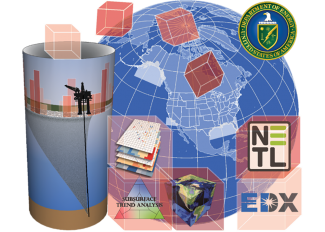The 2010 Deepwater Horizon oil spill — which released 130 million gallons of oil into the Gulf of Mexico over 87 days — put a spotlight on the urgent need for improved system-wide knowledge and advanced computational tools to predict and prevent future spills as oil and gas operations continue to expand into new territory.
To address the unique challenges associated with offshore hydrocarbon exploration, researchers from NETL’s Geo-Analysis & Monitoring Team created the Offshore Risk Modeling (ORM) suite to evaluate and reduce the risk of oil spill events. Consisting of eight digital modeling and visualization tools, the ORM suite represents more than six years of development, innovation and validation, resulting in a robust suite of advanced tools that are easily accessible for use by researchers and operators. The suite provides a comprehensive framework for future predictions, analyses and visualizations surrounding oil spill scenarios to better inform offshore drilling efforts, which works to make extracting critical resources safer while ensuring environmental protection.
The ORM suite incorporates terabytes of data from Energy Data eXchange™ — the Department of Energy’s Office of Fossil Energy’s virtual data library and laboratory — which allows for rapid large-scale predictions. The data used by the ORM suite accounts for several factors that could impact the fate and transport of an oil spill, from information surrounding the water column and ocean currents to emergency response availability, oil particulate behavior and more. The tools can simulate 4-D oil spill and blowout scenarios, identify critical subsurface characteristics such as pressure and porosity during drilling activities, evaluate emergency response preparedness and assess the integrity of offshore infrastructure.
What makes the ORM suite unique is that the tools can be used either individually or together to provide a full scope of data to evaluate, explore and ultimately prevent different spill scenarios. The suite’s analysis tools include:
- The Blowout Spill Occurrence Model™ (BLOSOM), an open-source, comprehensive model that predicts how and where oil will travel following offshore blowout and spill events.
- The Climatological Isolation and Attraction Model (CIAM), which applies mathematical theories to determine where oil and other particles in the ocean (e.g. debris, hazardous waste, plankton, etc.) are likely to be attracted or repulsed.
- Cumulative Spatial Impact Layers™ (CSIL), a spatial tool that rapidly identifies and quantifies potential socio-economic and environmental risk in different areas.
- Spatially Weighted Impact Model™ (SWIM), whichinforms decision-making by exploring relationships among oil spill simulations, response availability and potential risk.
- Subsurface Trend Analysis™ (STA), which combines traditional petroleum geology methods with data science to improve prediction of subsurface properties that are critical to calculating hazards.
- Variable Grid Method© (VGM), which communicates the uncertainty in data and modeled results.
“The ORM suite introduces a new way of evaluating the offshore environment,” said Kelly Rose, Ph.D., with NETL’s Geologic & Environmental Systems team. “In the past, smaller-scale datasets were the primary focus in informing decisions. Using large-scale spatial and temporal data to inform local-scale needs is a groundbreaking approach that has the potential to greatly increase the safety of hydrocarbon exploration and ensure responsible stewardship of the environment.”
To date, ORM components have been used by numerous domestic and international stakeholders, including government agencies, academia and industry. NETL researchers use the ORM suite to supplement ongoing research by analyzing and predicting geologic properties such as pressure, temperature, porosity and permeability in offshore regions where little data is available. Other tools and models currently in use have yet to offer such a comprehensive and holistic view of offshore data and would require the use of several technologies to complete what the ORM suite can do at once.
NETL is committed to discovering technological solutions for today and options for tomorrow. The ORM suite reflects the Lab’s world-class expertise in ensuring the safety and security of America’s energy foundation while protecting the environment for future generations.
For more information about this project, links to products of this research please click here.




